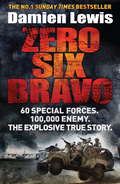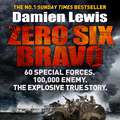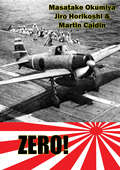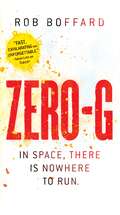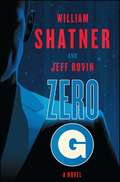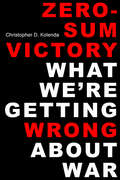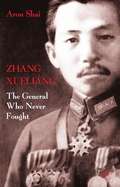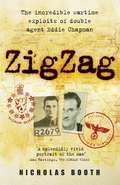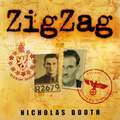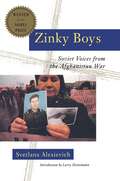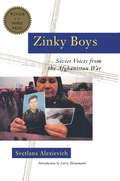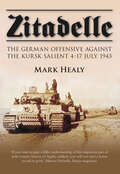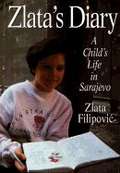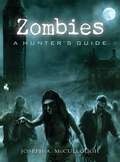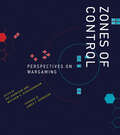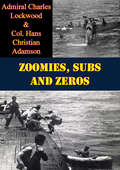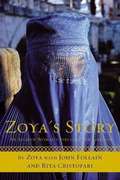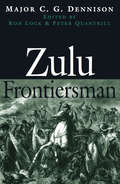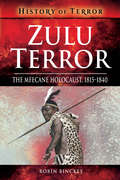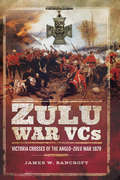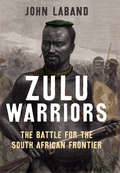- Table View
- List View
Zero Six Bravo: 60 Special Forces. 100,000 Enemy. The Explosive True Story
by Damien LewisThe Sunday Times No.1 bestseller.They were branded as cowards and accused of being the British Special Forces Squadron that ran away from the Iraqis. But nothing could be further from the truth. Ten years on, the story of these sixty men can finally be told. In March 2003 M Squadron - an SBS unit with SAS embeds - was sent 1,000 kilometres behind enemy lines on a true mission impossible, to take the surrender of the 100,000-strong Iraqi Army 5th Corps. From the very start their tasking earned the nickname 'Operation No Return'. Caught in a ferocious ambush by thousands of die-hard fanatics from Saddam Hussein's Fedayeen, plus the awesome firepower of the 5th Corps' heavy armour, and with eight of their vehicles bogged in Iraqi swamps, M Squadron launched a desperate bid to escape, inflicting massive damage on their enemies. Running low on fuel and ammunition, outnumbered, outmanoeuvred and outgunned, the elite operators destroyed sensitive kit and prepared for death or capture as the Iraqis closed their deadly trap. Zero Six Bravo recounts in vivid and compelling detail the most desperate battle fought by British and allied Special Forces trapped behind enemy lines since World War Two. It is a classic account of elite soldiering that ranks with Bravo Two Zero and the very greatest Special Forces missions of our time.
Zero Six Bravo: 60 Special Forces. 100,000 Enemy. The Explosive True Story
by Damien LewisDamien Lewis has spent twenty years reporting from conflict zones around the world. Zero Six Bravo--a Sunday Times number one bestseller--tells the story of "sixty special forces against 100,000--a feat of arms to take the breath away." (Frederick Forsythe) They were branded as cowards and accused desertion. But nothing could be further from the truth. Ten years on, the story of these sixty men can finally be told. In March 2003, M Squadron--an SBS unit with SAS embeds--was sent 1,000 kilometers behind enemy lines on a true mission impossible, to take the surrender of the 100,000-strong Iraqi Army 5th Corps, an operation so risky it earned the nickname â??Operation No Return' right out of the gate. Caught in a ferocious ambush by Saddam Hussein's Fedayeen, plus the awesome firepower of the 5th Corps' heavy armor, and with eight of their vehicles bogged in Iraqi swamps, M Squadron launched a desperate bid to escape, inflicting massive damage on their enemies. Running low on fuel and ammunition, outnumbered, and outgunned, the elite operators destroyed sensitive information and prepared for death or capture as the Iraqis closed their deadly trap. Zero Six Bravo contains previously unpublished information detailing the essential involvement of American troops in this astonishing military feat. Zero Six Bravo recounts in vivid and compelling detail the most desperate battle fought by British and allied Special Forces trapped behind enemy lines since World War Two.(P)2014 WF Howes Ltd
Zero!
by Martin Caiden Masatake Okumiya Jiro Hirokoshi"This is the thrilling saga of war in the air in the Pacific Theater of Operations during World War II told from the Japanese point of view. It is the story of the men who created, led, and fought in the deadly Zero fighter plane. In their own words, Jiro Horikoshi (who designed the Zero), Masatake Okumiya (leader of many Zero squadrons), and Saburo Sakai (Japan's leading surviving fighter ace) as well as many other men, tell the inside story of developing the Zero and Japan's air force. They tell what it felt like to bomb American ships and to shoot down American airplanes - and then of their shock when the myth of invincibility was shattered by the new Lightning, Hellcat, and Corsair fighters. They tell of the fight against the growing strength of a remorseless American enemy; and how, in desperation the Japanese High Command ordered the creation of deadly suicide squadrons, the Kamikaze. And finally they reveal their reaction to the dropping of the atomic bombs on Hiroshima and Nagasaki."-Print ed.
Zero-G (Outer Earth #2)
by Rob BoffardZERO-G is the nonstop sequel to Rob Boffard's Tracer, a brutal, gripping thrill-ride, where the hero moves like lightning and the consequences for failure are deadly.The clock is ticking down again for Riley Hale. She may be the newest member of Outer Earth's law enforcement team, but she feels less in control than ever. A twisted doctor bent on revenge is blackmailing her with a deadly threat. If Riley's to survive, she must follow his orders, and break a dangerous prisoner out of jail. To save her own skin, Riley must go against all her beliefs, and break every law that she's just sworn to protect. Riley's mission will get even tougher when all sectors are thrown into lock-down. A lethal virus has begun to spread through Outer Earth, and it seems little can stop it. If Riley doesn't live long enough to help to find a cure, then the last members of the human race will perish along with her. The future of humanity hangs in the balance. And time is running out.
Zero-G: A Novel (The Samuel Lord Series #1)
by William Shatner Jeff RovinA new science fiction adventure from William Shatner--famous for his role as Captain Kirk on Star Trek--about the intrepid, eighty-year-old FBI deputy director Samuel Lord and his quest to stop the Chinese from using a weapon that, unknown to them, could destroy the earth.In the year 2050, the United States sends the FBI to govern its space station, the Empyrean. Under the command of former fighter pilot and FBI field agent Samuel Lord, the space based "Zero-G" men are in charge of investigating terrorism, crime, corruption, and espionage beyond the Earth's atmosphere and of keeping an eye on the rival Chinese and Russian stations. During the Zero-G team's first days in space, a mysterious and beautiful scientist, Dr. May, shows up to the Empyrean claiming that important research has been stolen from her lab on the moon. Her arrival suspiciously coincides with timing of a tsunami that destroys part of the coast of Japan, and her unusual behavior makes Director Lord think that Dr. May might know more about the disaster than she's letting on. Meanwhile, the Chinese space station has gone mysteriously silent. In this gripping space adventure, Director Lord must connect the dots to discover who or what has caused the tsunami as well as subsequent disasters, and how Dr. May and the Chinese might be involved.
Zero-Sum Victory: What We're Getting Wrong About War
by Christopher D. KolendaThe military expert and author of Leadership presents &“the most thoughtful analysis yet of America&’s recent conflicts—and future challenges&” (Gen. Stanley A. McChrystal). Why have the major post-9/11 US military interventions turned into quagmires? Despite huge power imbalances in America&’s favor, capacity-building efforts, and tactical victories, the wars in Afghanistan and Iraq turned intractable. The US government&’s fixation on zero-sum, decisive victory in these conflicts is a key reason why these operations failed to achieve favorable and durable outcomes. In Zero-Sum Victory, retired US Army colonel Christopher D. Kolenda identifies three interrelated problems that have emerged from the government&’s insistence on zero-sum victory. First, the US government has no way to measure successful outcomes other than a decisive military victory, and thus, selects strategies that overestimate the possibility of such an outcome. Second, the United States is slow to recognize, modify, or abandon losing strategies. Third, once the United States decides to withdraw, bargaining asymmetries and disconnects in strategy undermine the prospects for a successful transition or negotiated outcome. Relying on historic examples and personal experience, Kolenda draws thought-provoking and actionable conclusions about the utility of American military power in the contemporary world—insights that serve as a starting point for future scholarship as well as for important national security reforms.
Zero-Sustainment Aircraft for the U.S. Air Force
by National Research CouncilOverall Air Force weapon system sustainment (WSS) costs are growing at more than 4 percent per year, while budgets have remained essentially flat. The cost growth is due partly to aging of the aircraft fleet, and partly to the cost of supporting higher-performance aircraft and new capabilities provided by more complex and sophisticated systems, such as the latest intelligence, surveillance, and reconnaissance (ISR) platforms. Furthermore, the expectation for the foreseeable future is that sustainment budgets are likely to decrease, so that the gap between budgets and sustainment needs will likely continue to grow wider. Most observers accept that the Air Force will have to adopt new approaches to WSS if it is going to address this problem and remain capable of carrying out its missions. In this context, the original intent of this 3-day workshop was to focus on ways that science and technology (S&T) could help the Air Force reduce sustainment costs. However, as the workshop evolved, the discussions focused more and more on Air Force leadership, management authority, and culture as the more critical factors that need to change in order to solve sustainment problems. Many participants felt that while S&T investments could certainly help--particularly if applied in the early stages ("to the left") of the product life cycle--adopting a transformational management approach that defines the user-driven goals of the enterprise, empowers people to achieve them, and holds them accountable, down to the shop level. Several workshop participants urged Air Force leaders to start the process now, even though it will take years to percolate down through the entire organization. These sustainment concerns are not new and have been studied extensively, including recent reports from the National Research Council's Air Force Studies Board and the Air Force Scientific Advisory Board.
Zhang Xueliang
by Aron ShaiThe first book to tell the strange and fascinating story of General Zhang Xue-liang, the Chinese-Manchurian 'Young Marshall' - a man who left an indelible mark on the history of modern China, but few know his story. Unlocking the mystery of this man's life, Aron Shai helps to shed light on 20th-century China.
Zigzag: The Incredible Wartime Exploits of Double Agent Eddie Chapman
by Nicholas BoothThe most remarkable double agent of World War II, Eddie Chapman was witty, handsome, and charming. Too bad he was also a con man, womanizer, and safe-cracker. To the British, though, he was known as ZigZag, one of MI5's most valuable agents. To the Abwehr-German military intelligence-he was known as Fritzchen (Little Fritz), and was believed to be one of their most valued and trusted spies. For three long years, Eddie played this dangerous double game, daily risking life and limb to help the Allies win the war. He was so charming that his German handler, Baron Stefan von Gröning, thought of Fritzchen as the son he never had. The Germans even awarded him the Iron Cross for spying for the Reich! They sent him to Britain, with the mission to blow up the De Havilland aircraft factory. How he and MI5 convinced the Germans that he had accomplished his mission stands as one of history's greatest acts of counterintelligence.Until now, Eddie Chapman's extraordinary double life has never been told, thwarted by the Official Secrets Act. Now all the evidence-including Eddie's MI5 file-has finally been released, paving the way for Nicholas Booth's enthralling account of Eddie's long and extraordinary life. A film of ZigZag is in the works with Tom Hanks producing and Mike Newell directing.
Zigzag: The incredible wartime exploits of double agent Eddie Chapman
by Nicholas BoothEddie Chapman was a womaniser, blackmailer and safecracker. He was also a great hero - the most remarkable double agent of the Second World War. Chapman became the only British national ever to be awarded an Iron Cross for his work for the Reich. He was also the only German spy ever to be parachuted into Britain twice. But it was all an illusion: Eddie fooled the Germans in the same way he conned his victims in civilian life. He was working for the British all along. Until now, the full story of Eddie Chapman's extraordinary exploits has never been told, thwarted by the Official Secrets Act. Now at last all the evidence has been released, including Eddie's M15 files, and a complete account of what he achieved is told in this enthralling book.
Zigzag: The incredible wartime exploits of double agent Eddie Chapman
by Nicholas BoothEddie Chapman was a womaniser, blackmailer and safecracker. He was also a great hero - the most remarkable double agent of the Second World War. Chapman became the only British national ever to be awarded an Iron Cross for his work for the Reich. He was also the only German spy ever to be parachuted into Britain twice. But it was all an illusion: Eddie fooled the Germans in the same way he conned his victims in civilian life. He was working for the British all along. Until now, the full story of Eddie Chapman's extraordinary exploits has never been told, thwarted by the Official Secrets Act. Now at last all the evidence has been released, including Eddie's M15 files, and a complete account of what he achieved is told in this enthralling book.
Zigzag: The incredible wartime exploits of double agent Eddie Chapman
by Nicholas BoothEddie Chapman was a womaniser, blackmailer and safecracker. He was also a great hero - the most remarkable double agent of the Second World War. Chapman became the only British national ever to be awarded an Iron Cross for his work for the Reich. He was also the only German spy ever to be parachuted into Britain twice. But it was all an illusion: Eddie fooled the Germans in the same way he conned his victims in civilian life. He was working for the British all along. Until now, the full story of Eddie Chapman's extraordinary exploits has never been told, thwarted by the Official Secrets Act. Now at last all the evidence has been released, including Eddie's M15 files, and a complete account of what he achieved is told in this enthralling book.
Zinky Boys: Soviet Voices From The Afghanistan War
by Svetlana AlexievichWinner of the Nobel Prize: “For her polyphonic writings, a monument to suffering and courage in our time.” ―Swedish Academy, Nobel Prize citation<P><P> From 1979 to 1989 a million Soviet troops engaged in a devastating war in Afghanistan that claimed 50,000 casualties―and the youth and humanity of many tens of thousands more. Creating controversy and outrage when it was first published in the USSR―it was called by reviewers there a “slanderous piece of fantasy” and part of a “hysterical chorus of malign attacks”―Zinky Boys presents the candid and affecting testimony of the officers and grunts, nurses and prostitutes, mothers, sons, and daughters who describe the war and its lasting effects. What emerges is a story that is shocking in its brutality and revelatory in its similarities to the American experience in Vietnam. The Soviet dead were shipped back in sealed zinc coffins (hence the term “Zinky Boys”), while the state denied the very existence of the conflict. Svetlana Alexievich brings us the truth of the Soviet-Afghan War: the beauty of the country and the savage Army bullying, the killing and the mutilation, the profusion of Western goods, the shame and shattered lives of returned veterans. Zinky Boys offers a unique, harrowing, and unforgettably powerful insight into the realities of war.<P><P> Translated by Larry Heinemann.
Zinky Boys: Soviet Voices From The Afghanistan War
by Svetlana AlexievichFrom the winner of the Nobel Prize for work that stands as "a monument to suffering and courage in our time" (Swedish Academy). Before the United States' invasion, a million Soviet troops fought a devastating war in Afghanistan that claimed 50,000 casualties—and the youth and humanity of many tens of thousands more. The Soviet Union talked about a "peacekeeping" mission, while the dead were shipped back in zinc-lined coffins. In this new translation, Zinky Boys weaves together the candid and affecting testimony of the officers and grunts, doctors and nurses, mothers, sons, and daughters who describe the war and its lasting effects. A "masterpiece of reportage" (Timothy Snyder, New York Review of Books) emerges of harrowing and unforgettable insight into war.
Zitadelle: The German Offensive Against the Kursk Salient 4-17 July 1943
by Mark HealyFew battles attract interest so much as the Battle of Kursk. Operation Zitadelle, the code name given by Hitler to the Wehrmacht's last offensive on the Eastern Front in July 1943, has acquired an almost mythic status as one of the greatest clashes of armour in the history of warfare. Long been depicted as the ‘the swan song of the German tank arm’ by virtue of the huge tank losses experienced by the Germans; the reality, in light of the emergence of new information proved it to be anything but, with historians previously accepting without question exaggerated Soviet accounts of the battle. For all the resources devoted to this operation by the Germans, Zitadelle was an abysmal failure; and whilst they were not outfought by the Red Army at Kursk, they were out-thought by commanders of outstanding quality. Zitadelle describes the German and Soviet tactics and explores the realities of the battles on sodden ground that culminated in the defeat of the panzers and the Soviet advance on the Reich.
Zlata's Diary: A Child's Life in Sarajevo
by Zlata Filipovic Christina Pribichevich-ZoricThis journal entry represents Zlata's insightful writing and the translators skill: "Thursday, October 14, 1993 Dear Mimmy, Those lunatics up in the hills must have read what I wrote about the shooting yesterday. They want to show me that they're still around. They went SHOOTING today. Shells fell around the market-place, and we don't know how Grandma and Grand-dad are. Poor things. These lunatics haven't just stolen from us our childhood, they've stolen from my grandparents and other old people a peaceful old age. They're not letting them live out the rest of their lives in peace. They had to ruin that too. I didn't have classes or music school today. They sent us home, so I'll spend the whole day at home reading, playing the piano, spending some time with Nejra and Haris. I was supposed to go to Mirna's today, but they spoiled that for me. I didn't tell you, Mimmy, that you're about to go out into the world. You're going to be published abroad. I allowed it, so you could tell the world what I wrote to you. I wrote to you about the war, about myself and Sarajevo in the war, and the world wants to know about it. I wrote what I felt, saw and heard, and now people outside of Sarajevo are going to know it. Have a good journey into the world. Your Zlata" A fine book for a book report. Teens sensitive to cruelty will want to share this diary with parents. This was a horrific piece of history.
Zombies
by Joseph McculloughThe dead have always stalked the dark corners of the earth. Since World War II, the number of zombie outbreaks has increased every year, while governments desperately try to cover up the facts. Zombies: A Hunter's Guide contains all of the information necessary to recognize and combat this growing threat. Beginning with an explanation of the historical origins of zombies, it follows their history straight through to the threat they pose to the world today. All varieties of zombie are catalogued and examined, giving their strengths and weakness, with a special emphasis on recognition and elimination. Finally, the book covers the tactics and equipment used in zombie fighting. Accompanied by numerous full-color reconstructions to help with identification, this book is a must for anyone on the frontlines of the Zombie Wars.From the Trade Paperback edition.
Zones of Control: Perspectives on Wargaming (Game Histories)
by Pat Harrigan Matthew G. KirschenbaumExaminations of wargaming for entertainment, education, and military planning, in terms of design, critical analysis, and historical contexts.Games with military themes date back to antiquity, and yet they are curiously neglected in much of the academic and trade literature on games and game history. This volume fills that gap, providing a diverse set of perspectives on wargaming's past, present, and future. In Zones of Control, contributors consider wargames played for entertainment, education, and military planning, in terms of design, critical analysis, and historical contexts. They consider both digital and especially tabletop games, most of which cover specific historical conflicts or are grounded in recognizable real-world geopolitics. Game designers and players will find the historical and critical contexts often missing from design and hobby literature; military analysts will find connections to game design and the humanities; and academics will find documentation and critique of a sophisticated body of cultural work in which the complexity of military conflict is represented in ludic systems and procedures.Each section begins with a long anchoring chapter by an established authority, which is followed by a variety of shorter pieces both analytic and anecdotal. Topics include the history of playing at war; operations research and systems design; wargaming and military history; wargaming's ethics and politics; gaming irregular and non-kinetic warfare; and wargames as artistic practice.ContributorsJeremy Antley, Richard Barbrook, Elizabeth M. Bartels, Ed Beach, Larry Bond, Larry Brom, Lee Brimmicombe-Wood, Rex Brynen, Matthew B. Caffrey, Jr., Luke Caldwell, Catherine Cavagnaro, Robert M. Citino, Laurent Closier, Stephen V. Cole, Brian Conley, Greg Costikyan, Patrick Crogan, John Curry, James F. Dunnigan, Robert J. Elder, Lisa Faden, Mary Flanagan, John A. Foley, Alexander R. Galloway, Sharon Ghamari-Tabrizi, Don R. Gilman, A. Scott Glancy, Troy Goodfellow, Jack Greene, Mark Herman, Kacper Kwiatkowski, Tim Lenoir, David Levinthal, Alexander H. Levis, Henry Lowood, Elizabeth Losh, Esther MacCallum-Stewart, Rob MacDougall, Mark Mahaffey, Bill McDonald, Brien J. Miller, Joseph Miranda, Soraya Murray, Tetsuya Nakamura, Michael Peck, Peter P. Perla, Jon Peterson, John Prados, Ted S. Raicer, Volko Ruhnke, Philip Sabin, Thomas C. Schelling, Marcus Schulzke, Miguel Sicart, Rachel Simmons, Ian Sturrock, Jenny Thompson, John Tiller, J. R. Tracy, Brian Train, Russell Vane, Charles Vasey, Andrew Wackerfuss, James Wallis, James Wallman, Yuna Huh Wong
Zoomies, Subs And Zeros
by Admiral Charles Lockwood Col. Hans Christian AdamsonThe exploits of the Submarine Rescue League, which had the job of picking up American flyers shot down while attacking objectives in the Pacific.'In writing this book, the authors had a triple purpose.First, to write the superbly human history of the Submarine Lifeguard League while those who participated in its creation and in its splendid work are still among us to tell that story. It is a chapter of Naval and Air Force operations in the Pacific that richly deserves preservation.Second, to convey to submariners whose vessels took part in the saving of the lives of hundreds of Air Force, Navy, and Marine Corps men an essential picture of the overall scope of their activities; as well as to give aviators whose lives were saved by submarines--and their families--a view of the far-flung operations established for snatching airmen from Japs as well as from death at sea.There remains one more reason for the writing of this book and, perhaps, it is, after all, the most important: namely, to impress upon those who have a voice in such matters at defense and Congressional levels that with new long-range planes and nuclear powered submarines, the lifesaving know-how acquired by submarine and air commanders through bitter and time-consuming experiences should be preserved for future generations of submariners and airmen.'-Author's Preface.
Zoya's Story: An Afghan Woman's Struggle for Freedom
by Zoya John Follain Rita CristofariZoya's Story is a young woman's searing account of her clandestine war of resistance against the Taliban and religious fanaticism at the risk of her own life. An epic tale of fear and suffering, courage and hope, Zoya's Story is a powerful testament to the ongoing battle to claim human rights for the women of Afghanistan. Though she is only twenty-three, Zoya has witnessed and endured more tragedy and terror than most people do in a lifetime. Zoya grew up during the wars that ravaged Afghanistan and was robbed of her mother and father when they were murdered by Muslim fundamentalists. Devastated by so much death and destruction, she fled Kabul with her grandmother and started a new life in exile in Pakistan. She joined the Revolutionary Association of the Women of Afghanistan, which challenged the crushing edicts of the Taliban government, and she made dangerous journeys back to her homeland to help the women oppressed by a system that forced them to wear the stifling burqa, condoned public stoning or whipping if they ventured out without a male chaperon, and forbade them from working. Zoya is our guide, our witness to the horrors perpetrated by the Taliban and the Mujahideen "holy warriors" who had defeated the Russian occupiers. She helped to secretly film a public cutting of hands in a Kabul stadium and to organize covert literacy classes, as schooling-branded a "gateway to Hell" -- was forbidden to girls. At an Afghan refugee camp she heard tales of heartrending suffering and worked to provide a future for families who had lost everything. The spotlight focused on Afghanistan after the New York and Washington terrorist attacks highlights the conditions of repression and fear in which Afghan women live and makes Zoya's Story utterly compelling. This is a memoir that speaks louder than the images of devastation and outrage; it is a moving message of optimism as Zoya struggles to bring the plight of Afghan women to the world's attention.
Zoya: An epic, unputdownable read from the worldwide bestseller
by Danielle SteelTHE WORLD'S FAVOURITE STORYTELLERNEARLY ONE BILLION COPIES SOLD One woman's odyssey through a century of turmoil . . . St Petersburg: one famous night of violence in the October Revolution ends the lavish life of the Romanov court forever - shattering the dreams of young Countess Zoya Ossupov.Paris: under the shadow of the Great War, émigrés struggle for survival as taxi drivers, seamstresses and ballet dancers. Zoya flees there in poverty - and leaves in glory.America: a glittering world of flappers, fast cars and furs in the Roaring Twenties; a world of comfort and café society that would come crashing down without warning. An epic and romantic tale from one of the best-loved writers of all time. Perfect for fans of Penny Vincenzi, Lucinda Riley and Maeve BinchyPRAISE FOR DANIELLE STEEL:'Emotional and gripping . . . I was left in no doubt as to the reasons behind Steel's multi-million sales around the world' DAILY MAIL'Danielle Steel is undeniably an expert' NEW YORK TIMES
Zulu Frontiersman
by Major C. G. DennisonIt was said of George Dennison that he had seen more active service in southern Africa than any other living man. An eminent soldier cast from a colonial mould of bitter experience, rather than of a formal military education, he was also a frontiersman equal in standing to any legendary figure of the American West. His military career saw him rise from an uncouth trooper with the Bloemfontein Rangers to, fifty years later, a distinguished officer whose advice was sought by the likes of Lord Kitchener, Sir Garnet Wolseley and other British military names of fame. During this time Dennison encountered many foes, some he would have known as neighbours, or men who had lately been his comrades-in-arms. He fought against Afrikaners, Dutchmen, Voortrekkers and the Boers. His black foes were also diverse; the stealthy Xhosa of the eastern Cape; the battle-axe wielding Basutos from their lofty kingdom in the clouds; the Transvaal baPedi, the masters of fortification, and most impressive of all, the amaZulu warriors of King Cetshwayo. In Zulu Frontiersman, Dennison recounts his remarkable exploits in rich and lively prose. Originally published in 1904 in abridged form (under the title A Fight to the Finish) his memoirs have now been expertly reworked by Ron Lock and Peter Quantrill in order to reinstate some of the fascinating details missing from the earlier published account, including for example Dennison's involvement in and dramatic escape from the battle of Hlobane.
Zulu Terror: The Mfecane Holocaust, 1815–1840 (History of Terror)
by Robin BinckesThe historian and author of The Great Trek recounts the devastating period of violence among indigenous peoples in early 19th century southern Africa. From 1815 to 1840, southeastern Africa experienced a devastating period of warfare between the Zulus, the Matabele, and other indigenous peoples. Though the causes of the unrest—which the Zulu called the Mfecane—are still debated by historians, we know that hundreds of thousands of lives lost. Some estimate the total number of deaths to be near two million. At the center of the turmoil was the Zulu Kingdom and its King Shaka, whose wars of expansion sparked mass migrations among smaller tribes. One of Shaka&’s lieutenants, Mzilikazi Khumalo, escaped execution and began a trail of destruction from Zululand north to the Highveld. Refugees from Mzilikazi&’s warpath then formed their own alliance—including with the Dutch-speaking Voortrekkers, arriving on their own &“Great Trek&” to escape British control. Finally defeated in 1836 by the Voortrekkers in a nine-day battle, Mzilikazi and his followers crossed the Limpopo River and founded the kingdom of the Matabele in what is now Zimbabwe.
Zulu War VCs: Victoria Crosses of the Anglo-Zulu War, 1879
by James W. BancroftThe Anglo-Zulu War lasted only six months in 1879, but in that relatively short time twenty-three men were awarded the Victoria Cross for gallantry under most trying and dangerous circumstances. Zulu warriors gave no mercy and expected none in return, yet half of the awards were given to men who went back into the midst of fierce fighting to rescue stranded comrades, well-aware that they risked suffering a particularly brutal death.Two men received posthumous awards for their efforts to save the Queens color of their regiment after the disastrous engagement against overwhelming numbers of warriors at Isandlwana, and perhaps the most famous of all awards of the Victoria Cross were the eleven gained for the immortal defence of Rorkes Drift, the battle brought back to the public consciousness by the motion picture _Zulu!_The conflict has never left the publics imagination, and continues to stir hot debate among military historians and enthusiasts.With information compiled over four decades by James W. Bancroft, a well-known and respected historian and author of several publications on the subject, this book brings together more information about the men than has ever before been collected together in one publication.
Zulu Warriors:The Battle for the South African Frontier
by John LabandToward the end of the nineteenth century, the British embarked on a concerted series of campaigns in South Africa. Within three years they waged five wars against African states with the intent of destroying their military might and political independence and unifying southern Africa under imperial control. This is the first work to tell the story of this cluster of conflicts as a single whole and to narrate the experiences of the militarily outmatched African societies.<P> Deftly fusing the widely differing European and African perspectives on events, John Laband details the fateful decisions of individual leaders and generals and explores why many Africans chose to join the British and colonial forces. The Xhosa, Zulu, and other African military cultures are brought to vivid life, showing how varying notions of warrior honor and manliness influenced the outcomes for African fighting men and their societies.
